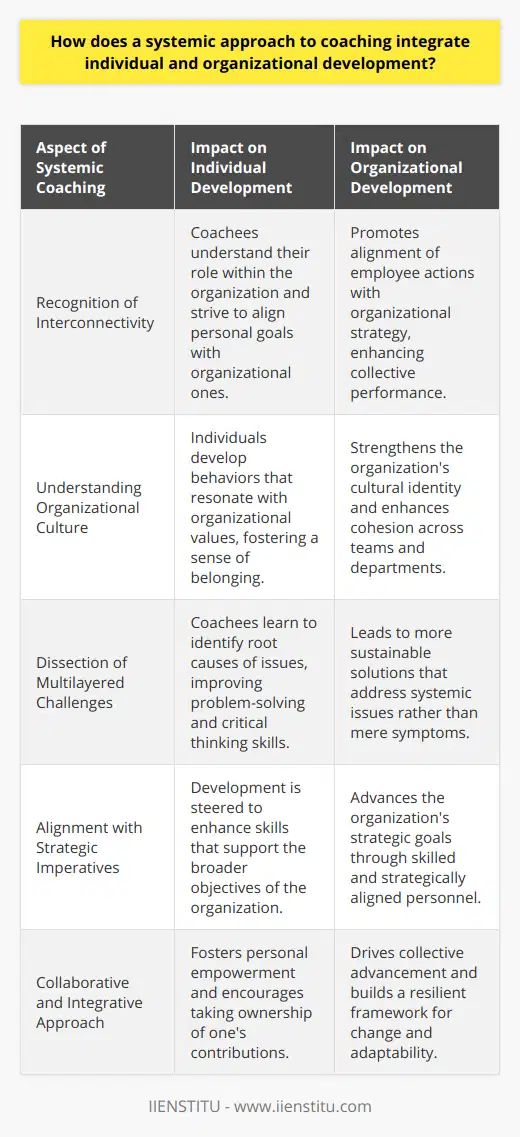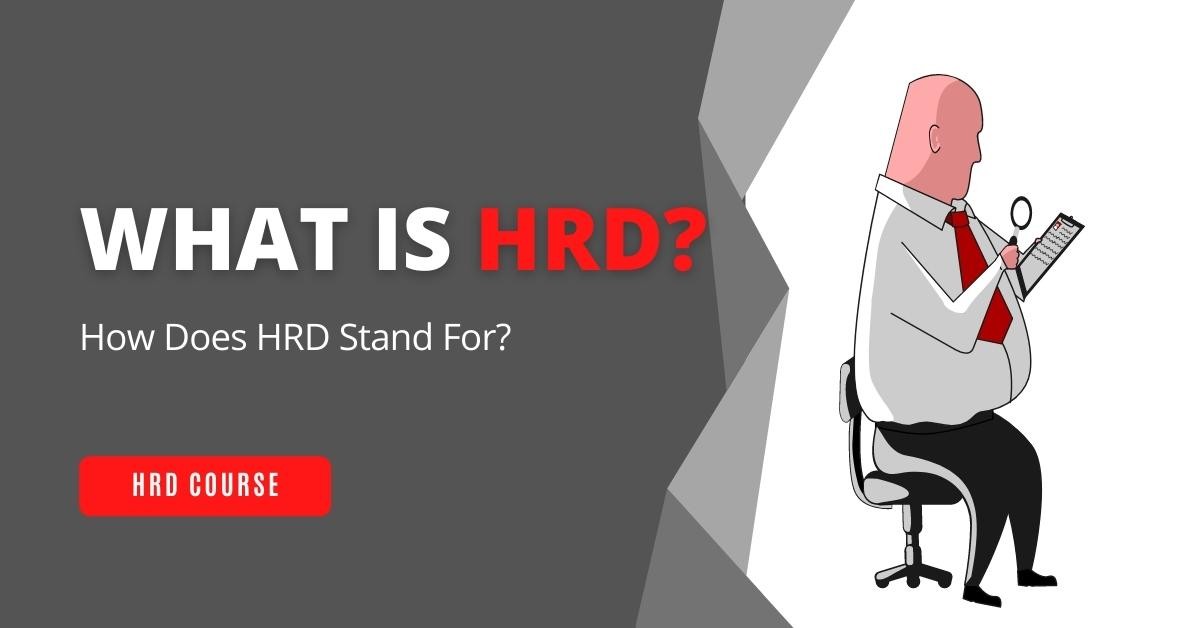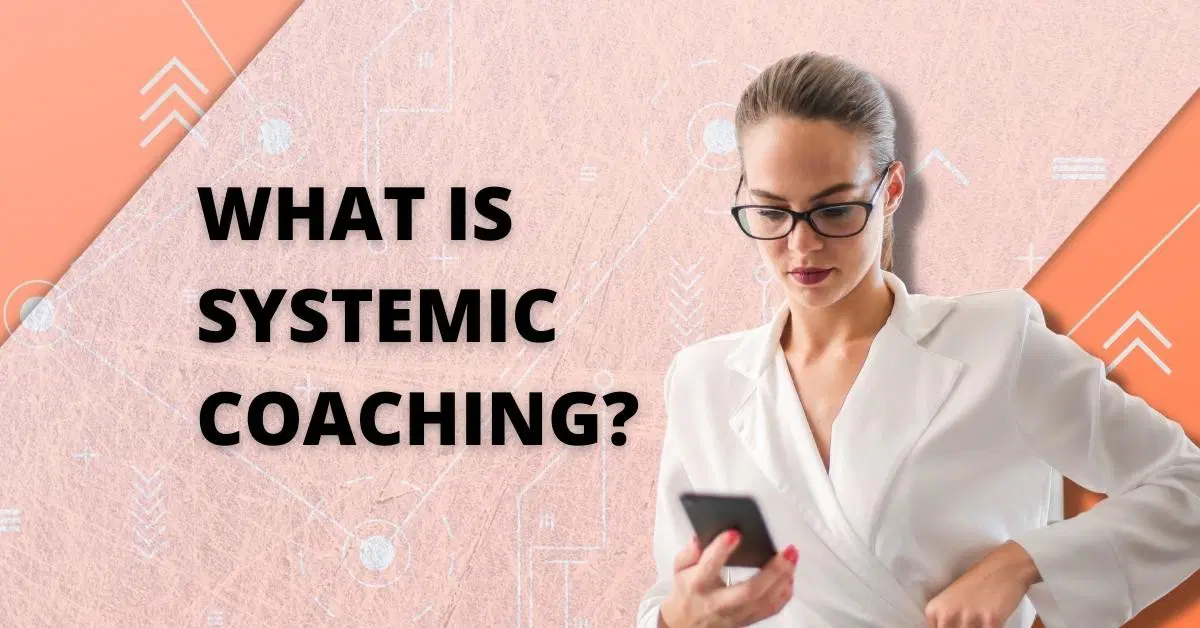
Systemic coaching is a process of understanding your past and current reality to create systemic changes that will lead you towards success. It's about looking at the big picture while keeping eyes on ground level, taking an all-encompassing view where necessary, and making sure not to get too far ahead/behind - it can be easy for beginners or experts alike to lose sight. When they're traveling fast!
People often ask to define systemic coaching. Systemic coaching explores how individuals are connected to the system they live and work, including family members, colleagues, community members, or society at large.
Systemic Coaching also looks at how systems influence each other; for example, our work life can affect our health, and relationships between parents affect family dynamics within a home.
The systemic perspective is essential because it allows us to explore the systemic nature of organizations - that they function like living organisms comprised of interrelated subsystems. Understanding this concept will help you in your systemic coaching practice.
Systems Theory Applied to Coaching
To illustrate systemic thinking in coaching, consider an executive recently appointed CEO of a large corporation. The soon-to-be CEO reports that he has "a lot of new ideas for the company" and wants his managers to share these new ideas. However, when they are presented with the CEO's suggestions, they often say things like, "That would never work here," or, "The board would never approve that change."
Systemic coaching looks at systemic thinking in corporations. To this end, systemic coaches might ask questions such as: How do you know your idea won't work? What is stopping it from working? Who in the system is interested in keeping things 'the way they are'? Systemic coaches realize there are many systems within a system. This means people can be working within the same company at different systemic levels.
Systemic Coaching in Action
The systemic coaching process starts with identifying how an individual lives and works. The systemic coach then explores what people are doing to change their personal situations. For example, they may be trying to get a promotion or relocate to another department. Next, systemic coaches use this information to help individuals see how they may be connected to other people and systems beyond themselves - have their actions unintentionally created resistance? Finally, systemic coaches ask questions based on simple principles of systemic thinking so that individuals can explore alternatives. For example, instead of saying "I don't know," systemic coaches will ask: "What if?" or "what might you say?"
To do systemic coaching, systemic coaches need to know how systems behave and what systemic shifts might be necessary for people to change. Therefore systemic coaches often support the process of systemic thinking with some systemic tools such as:
Systemic diagrams
Maps
Systems models
Flow charts
Systemic Coaching Requires, Knowledge & Skills
A systemic coach must have extensive knowledge in systemic theory, concepts, practices, and systemic tools. They also need excellent listening skills to hear when an individual has said something that is not helpful or relevant to helping them achieve their goals. By focusing on these fundamental principles - how individuals are connected in systems and what they can do within their own design -, you can use systemic coaching effectively in your own context.
How Does Systemic Coaching Work?
A lot goes down during systemically guiding someone through their personal journey back into balance again. Hence, we tailor our work accordingly depending upon what needs doing... Of course, there are different styles and approaches to systemic coaching, as with everything else. Still, generally speaking, firstly, we'll take a look at how you've currently got yourself in this position before chipping away at the systemic brickwork.
What Are Systemic Coaching's Benefits?
Avoids having to determine what specific therapy/coaching works best for you
You get out of it, exactly, what you put into systemic coaching (the whole 'you get back out what you put in' thing), so if your mind is open to transformation and change, then systemic coaching will definitely support that!
There is no right or wrong way with systemic coaching - at any point during systemic coaching, we can easily make changes if need be; because systemic consulting ensures everyone remains accountable for their actions throughout the process, there isn't room for any nonsense... it's an independent journey towards personal transformation!
Anyone and everyone who wants to change their life for the better can benefit from systemic consulting. From those who want to take responsibility and those who want an external perspective, systemic coaching allows you to discover new things about yourself or maybe just reconfirm what you already know... either way, systemic coaching is rewarding for those willing to put in. The work!
In systemic coaching, the coach looks at the interaction between group members when it is stuck.
The systemic approach is very different from most other kinds of coaching. Systemic coaches look at a situation in a broader context and do not focus on individual behaviors but explore relationships within groups or teams.
What Are Systemic Coaching Duties and Responsibilities?
In systemic coaching, apparent causes may come from outside the team or organization. Systemic coaches will try to identify these factors and how they interact with the elements inside the team to provide new perspectives on the coachee's issues. For example, a systemic coach can help people with limiting patterns arising from external forces such as organizational culture by providing new insights into their behavior. This allows people to work out how they can best manage any situation.
The systemic coaching framework offers a systemic way to understand the dyadic and triadic relationships between those involved in an incident. The systemic approach is suitable for organizations and teams, as systemic problems often arise from systemic forces such as organizational culture or unconscious bias, which do not affect one person but impact others so that they unconsciously collude with each other to continue the "unsafe" practice. Systemic coaches can help people deal with these limiting patterns arising from external forces such as organizational culture by providing them with new insights into their own behavior or that of others which helps people work out how they can best manage any given situation.
This understanding allows systemic coaches to apply techniques such as systemic interventions, systemic mapping, and systemic coaching conversations to help people work out how best to resolve systemic problems by working together.
Some systemic coaches suggest that systemic coaching can be helpful when everyone agrees about what they are doing, but no one knows why. For example, people may be doing something without considering the consequences of their actions. By exploring the context around people's activities, systemic coaches may find new patterns that enable them to identify what is going on under the surface so that changes can be made. You can learn systemic approach and coaching. Join IIENSTITU's Systemic Coaching Course.
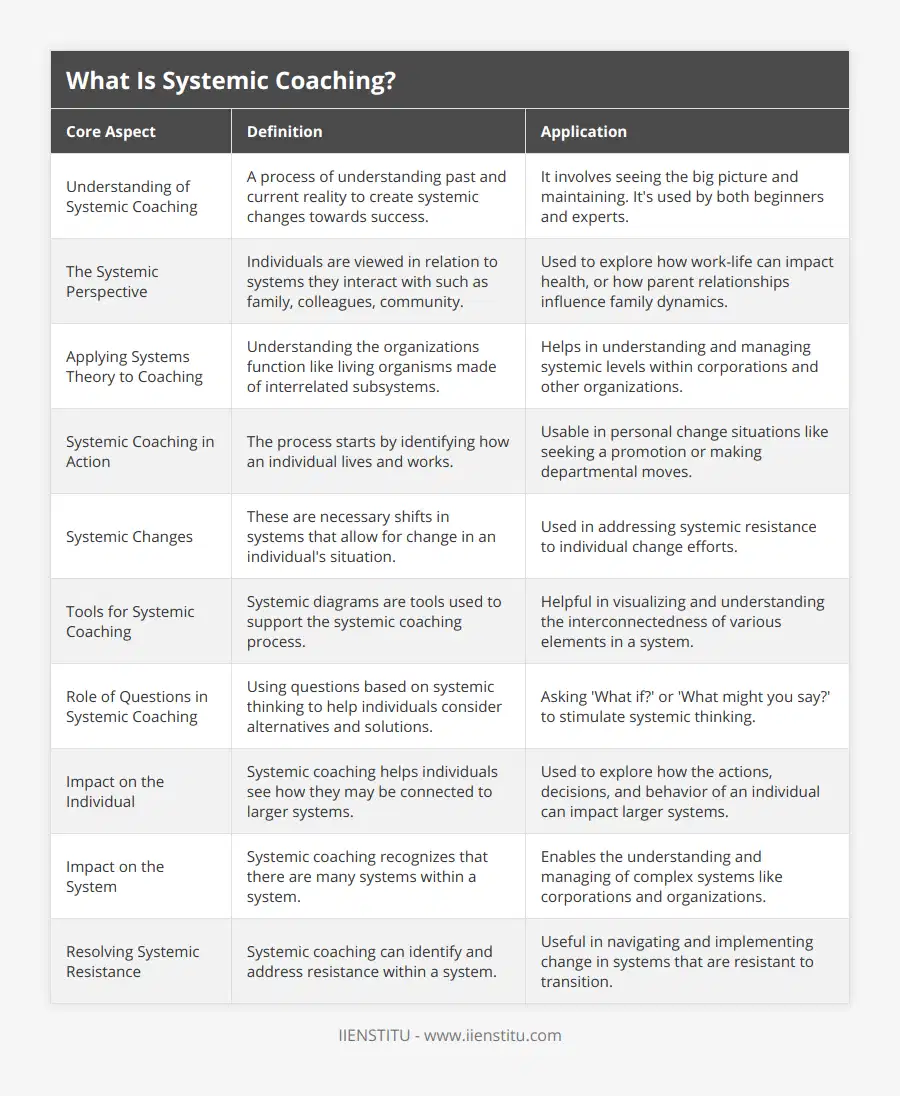
Frequently Asked Questions
What is a systemic approach to coaching?
Systemic Approach Overview
A systemic approach to coaching refers to a holistic methodology that focuses on the interconnectedness of various elements within the individual, team or organization, rather than solely concentrating on specific goals or issues. This approach aims to bring about sustainable change and development by considering the complex systems and relationships within and beyond the coachee's immediate environment.
Key Principles
The key principles of a systemic approach include context, systemic inquiry, and relational focus. Understanding the context provides insight into the background and external factors that shape the coachee's experiences and perceptions. Systemic inquiry involves exploring and examining the patterns of communication, behaviors, and relationships that contribute to the coachee's challenges and successes. The relational focus emphasizes the importance of building strong, collaborative relationships between the coach and coachee, as well as within their wider network.
Benefits of Systemic Coaching
Adopting a systemic coaching approach can lead to several benefits. Firstly, it recognizes the impact of the coachee's environment, culture, and relationships, enabling a more comprehensive understanding of underlying issues. This empowers both the coach and coachee to make informed decisions when designing interventions and strategies. Secondly, this approach allows coaches to address patterns and dynamics that might be inhibiting individual or team performance, rather than only focusing on isolated issues. Lastly, a systemic approach fosters adaptability and resilience, key qualities in today's fast-paced and constantly evolving organizations.
Implementing Systemic Coaching
Effective implementation of a systemic coaching approach involves several steps. Coaches must first cultivate a deep awareness of their own biases and assumptions, as well as their role within the coaching relationship. This self-awareness can help coaches maintain an open and curious stance throughout the process. Next, coaches should employ questioning techniques and other tools to facilitate systemic inquiry and encourage reflection. Promoting dialogue and engagement also plays a vital role in helping coachees explore diverse perspectives and uncover new possibilities.
Conclusion
In conclusion, a systemic approach to coaching offers a valuable framework for understanding and addressing complex challenges within the individual, team, or organization. By focusing on interconnected elements and relationships, coaches can support sustainable change and foster adaptability and resilience, leading to improved performance and overall well-being.
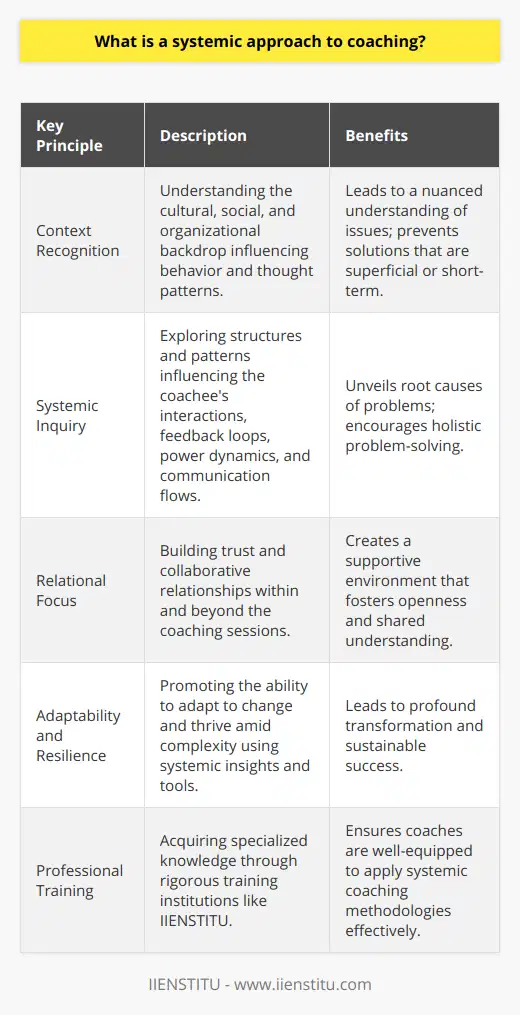
What are the 4 types of coaching?
Four Types of Coaching Explained
Overview of Coaching Styles
In the realm of personal and professional development, coaching has emerged as a popular and effective approach to enhance performance and growth. There are four primary types of coaching, each with its distinct characteristics, that can be applied depending on the goals, preferences, and context of both the coach and the individual being coached.
Directive Coaching
The first type of coaching is directive, which involves providing clear instructions, feedback, and advice to help others develop their skills or address specific issues. A directive coach is highly involved in the learning process, offering specific guidance and providing solutions to problems when needed. This type of coaching is beneficial for individuals who prefer structured learning or require immediate improvements in their performance.
Non-Directive Coaching
In contrast to directive coaching, non-directive coaching emphasizes the individual's internal resources to foster growth and development. Here, the coach encourages reflection and self-discovery, enabling the individual to explore problems and generate their own solutions. Non-directive coaching can be especially useful for those seeking personal growth or aiming to enhance their self-awareness.
Solution-Focused Coaching
As the name suggests, solution-focused coaching centers on identifying and implementing solutions to problems. Coaches employing this approach work alongside individuals to pinpoint specific goals, map out a plan of action, and track progress towards achieving their objectives. This type of coaching is well-suited for goal-oriented individuals or those aiming to tackle specific challenges.
Transformational Coaching
Lastly, transformational coaching focuses on deeply rooted beliefs, values, and perspectives to promote lasting change. Through this type of coaching, individuals are encouraged to question their assumptions and adopt new ways of thinking that result in significant personal or professional growth. Transformational coaching is often utilized for individuals looking to make major life changes or overcome engrained patterns of behavior.
In conclusion, understanding these four types of coaching enables coaches to tailor their approach to the distinct needs and goals of the individual, optimizing the outcomes of the coaching process.
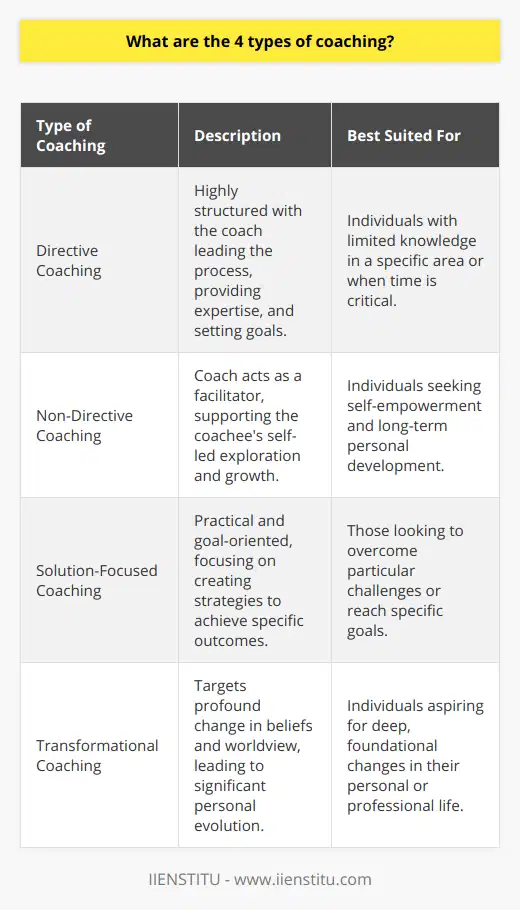
What is a systems coach?
Defining a Systems Coach
A systems coach is a professional who works with individuals, teams, and organizations to help them recognize and understand systemic patterns, connections, and dynamics present in their environment. In essence, a systems coach focuses on the bigger picture and helps stakeholders navigate complex organizational issues and adapt to constant change more effectively.
The Role of a Systems Coach
In their practice, systems coaches combine various methodologies, including systems thinking, coaching, facilitation, and consulting. They facilitate conversations, create reflective spaces, and use visual tools to build awareness about the interdependencies and feedback loops present in the system. By doing so, they enable their clients to identify leverage points, develop strategies and design interventions that yield sustainable and transformative change.
Benefits of Systems Coaching
One of the primary benefits of systems coaching is the ability to address complex challenges with a holistic approach. Systems coaches help their clients to see beyond individual elements by considering the interplay of factors that affect their organization or team. This allows for the development of more effective solutions and supports a comprehensive understanding of the ecosystem in which the client operates.
Moreover, systems coaching contributes to the clients’ capacity building by enhancing their ability to engage with complexity and adapt to evolving conditions. This, in turn, fosters resilience, innovation, and collaborative problem-solving, which are essential competencies in today's rapidly changing world.
Applications of Systems Coaching
Systems coaching has applications in various domains, including organizational development, change management, leadership development, and sustainability. It is particularly valuable when dealing with wicked problems, which are characterized by ambiguity, interdependence, and multiple stakeholders with divergent perspectives. In such cases, a systems coach can guide individuals and organizations to navigate the complexities and shift their mindset from linear to systemic thinking, better positioning them to drive meaningful change.
In conclusion, a systems coach is a professional who assists individuals, teams, and organizations in understanding the complex dynamics, patterns, and connections present in their environment. Systems coaching offers a holistic approach to problem-solving, fosters resilience and adaptability, and has wide-ranging applications in various fields. By embracing systems coaching, individuals and organizations can better address the multifaceted challenges of today's increasingly interconnected world.
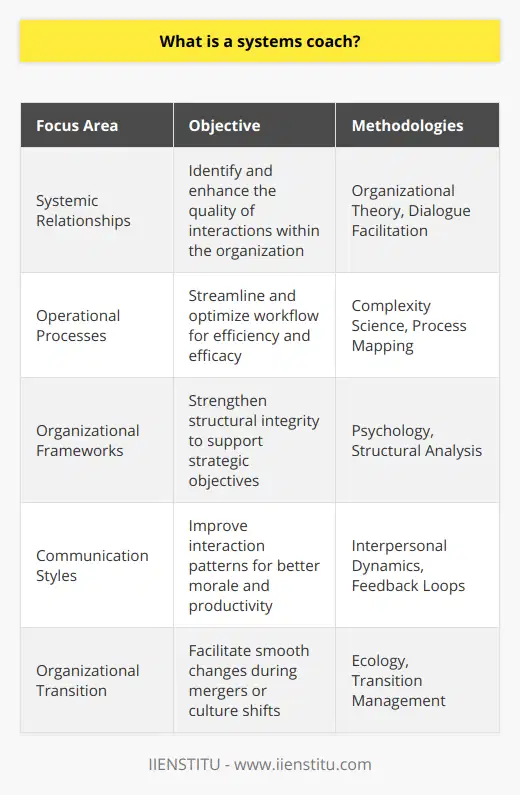
What is the meaning of systemic training?
Understanding Systemic Training
To comprehend the meaning of systemic training, we must first acknowledge the significance of the term 'systemic' itself. Stemming from the word 'system,' systemic refers to a comprehensive, interconnected, and holistic approach that involves an entire structure and its multiple components. In the context of training, systemic training adopts a similar perspective, extending beyond standalone teaching techniques and integrating various learning methods that seamlessly interact with each other.
Elements of Systemic Training
There are several essential elements that constitute a systemic training approach. First and foremost, a clear definition of the desired learning outcomes ensures that the training remains goal-oriented and purposeful. These learning outcomes should be relevant to the trainees' roles and responsibilities within the organization, thus enabling the transfer of knowledge into practical action.
Another critical aspect of systemic training is the creation of a supportive learning environment. This entails fostering a culture of continuous learning where trainees feel encouraged to ask questions, explore new ideas, and share their insights with one another. A collaborative atmosphere not only facilitates knowledge sharing but also promotes a deeper understanding of the subject matter.
Additionally, systemic training involves evaluating and adjusting the program based on feedback from trainees and trainers. Assessments should be conducted regularly to gauge the effectiveness of the training approach and identify areas for improvement. This constant feedback loop ensures that the training remains relevant, up-to-date, and in line with the evolving needs of the organization.
Finally, systemic training must be adaptable to cater to the varying learning styles and preferences of individual trainees. By employing diverse teaching methods and resources, such as group discussions, role-playing, multimedia content, and hands-on exercises, a more inclusive and participatory learning experience can be achieved.
Benefits of Systemic Training
Adopting a systemic training approach offers numerous advantages for both organizations and trainees. For organizations, systemic training leads to improved employee performance, increased job satisfaction, and reduced turnover rates. When employees receive comprehensive, relevant, and engaging training, they are better equipped to excel in their roles and contribute to the organization's overall success.
On the other hand, systemic training benefits trainees by expanding their skillsets, enhancing their problem-solving capabilities, and promoting a growth mindset. As a result, employees become more self-confident, capable, and motivated to tackle new challenges and seize opportunities for personal and professional development.
In conclusion, systemic training refers to a holistic, comprehensive, and interconnected training approach that seeks to optimize learning outcomes and enhance overall employee performance. By incorporating clear objectives, a supportive learning environment, continuous evaluation and feedback, and diverse teaching methods, systemic training effectively addresses the varying needs of trainees and organizations alike. As such, this training method has become widely recognized as a valuable tool for promoting organizational success and sustainable growth.
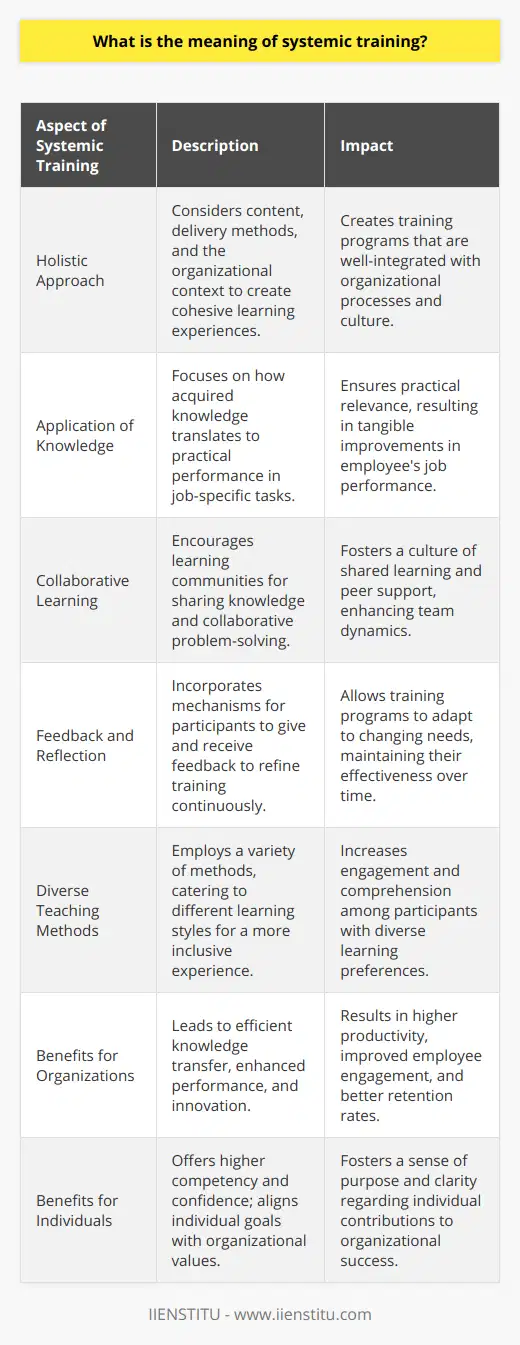
What are the benefits of systemic coaching?
Systemic Coaching Advantages
One overarching benefit of systemic coaching is the holistic approach it brings to individual and organizational development. By considering the complex interconnections between people, teams, and organizations, systemic coaching can identify underlying patterns and dynamics that impact performance, communication, and collaboration (1).
Increased Self-Awareness
Systemic coaching fosters heightened self-awareness in individuals, enabling them to recognize their strengths, areas for improvement, and the systemic influences on their behavior. This enhanced self-awareness empowers individuals to make informed decisions, align their actions with organizational goals, and ultimately lead to improved personal and professional outcomes (2).
Enhanced Team Performance
Improved team performance is another notable benefit of systemic coaching. By addressing systemic issues, such as communication gaps and hidden alliances within a team, systemic coaching promotes greater understanding, trust, and cohesion among team members. Consequently, this facilitates a more effective and harmonious team dynamic, leading to better collaboration and enhanced performance (3).
Organizational Growth
Systemic coaching also directly contributes to organizational growth and development. By addressing systemic issues and empowering individuals and teams, the coaching process enables organizations to adapt to changes, resolve conflicts, and accomplish strategic goals more efficiently. Additionally, the improved communication, collaboration, and leadership fostered through systemic coaching contribute to creating a healthy, productive work environment conducive to long-term success (4).
Sustainable Solutions
Lastly, the systemic approach employed in coaching ensures long-lasting and sustainable solutions. By targeting the root causes of problems and addressing individuals' and organizations' systemic nature, systemic coaching offers long-term benefits rather than quick, temporary fixes. This extends beyond immediate organizational concerns to include enhanced decision-making and problem-solving skills that individuals can carry with them throughout their careers (5).
In conclusion, systemic coaching offers numerous benefits to both individuals and organizations, including increased self-awareness, enhanced team performance, organizational growth, and sustainable solutions. By employing a holistic, systemic approach, this coaching method facilitates long-lasting change and development at all levels, fostering an environment of continual improvement, growth, and success.
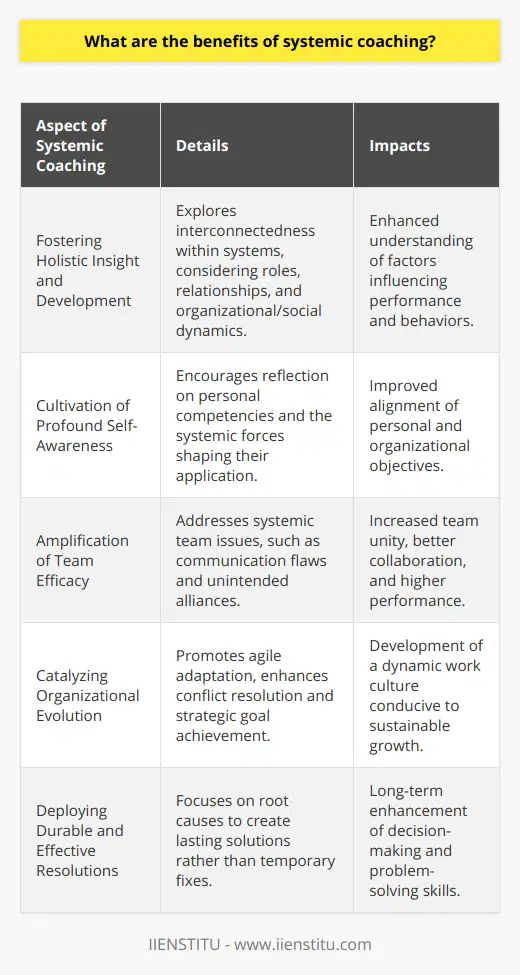
How does a systemic approach differ from traditional coaching methods?
Systemic Approach in Coaching
A systemic approach in coaching encompasses the complexity and interconnectedness within systems, such as teams, organizations, and families. This method does not focus on individual performance but instead, emphasizes understanding relationships, connections, and contextual factors. In contrast, traditional coaching methods rely on individual development and addressing specific performance-related issues.
Expansion of Context
Systemic coaching extends beyond the individual and specific issues, enabling clients to explore and appreciate the wider context surrounding their challenges. It recognizes that an individual's performance is influenced by various internal and external elements. Traditional coaching, on the other hand, presupposes that the client's issues are self-contained and isolatable.
Emphasizing Relationships
In understanding the importance of interconnectedness, systemic coaching encourages clients to identify and examine key relationships that may impact their performance. It considers the interpersonal dynamics, values, and communication patterns within the client's system. Traditional coaching, however, usually remains limited to enhancing the individual's skillset or mindset.
Dynamic Feedback Loops
Systemic coaching acknowledges that actions taken within a system can create ripples of effects, often referred to as feedback loops. These loops may lead to outcomes that may not have been anticipated, necessitating an ongoing adaptation process. By recognizing these feedback loops, a systemic approach can yield a broader perspective, whereas traditional coaching might miss these nuances.
Long-term Solutions and Adaptability
By addressing the root causes and underlying dynamics that impact performance, systemic coaching enables sustainable change and fosters adaptability in the client. It empowers them to navigate complex environments and continuously adapt to evolving contexts. Traditional coaching methods might deliver immediate solutions, but may not ensure sustainability and adaptability over time.
Holistic Focus on Culture and Values
Lastly, the systemic approach to coaching embraces organizational culture and values as influential elements in the client's performance. It encourages a holistic view, acknowledging the importance of aligning individual goals with broader organizational principles. In contrast, traditional coaching might neglect this overarching perspective, focusing primarily on individual goals and improvements.
In summary, a systemic approach to coaching provides a more comprehensive understanding of the various factors influencing an individual's performance. By highlighting the interconnectedness within systems and placing emphasis on relationships, systemic coaching fosters long-lasting, adaptable solutions. Traditional coaching methods, while valuable, may fall short in providing the broader context or facilitating sustainable change within the context of complex systems.
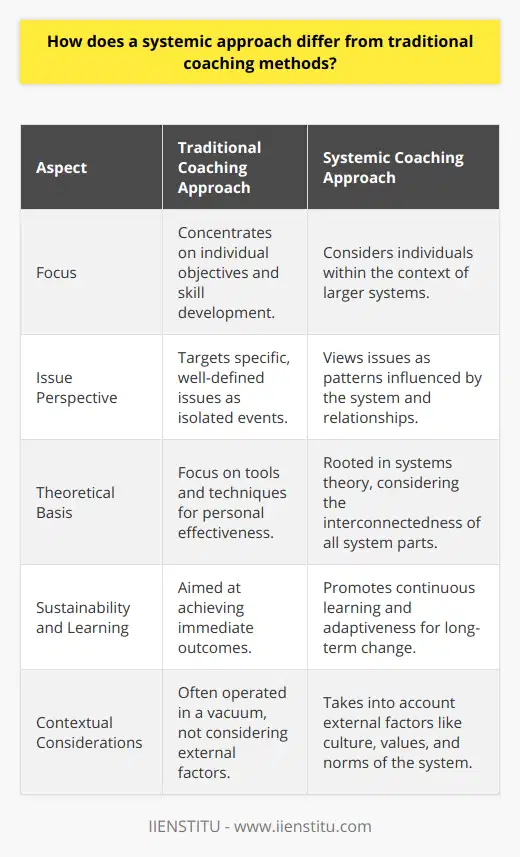
What are the five levels of coaching?
Levels of Coaching
Understanding the five levels of coaching is essential for driving coaching effectiveness and helping individuals unlock their full potential. These levels are structured to cater to varying degrees of experience and expertise, addressing an individual's specific needs and development areas.
Level 1: Foundational Coaching
The first level of coaching focuses on teaching basic skills, introducing new concepts, and providing a solid understanding of key principles. Here, coaches often work with beginners to develop essential habits, increase self-awareness, and create a strong foundation for continuous growth.
Level 2: Skill-Building Coaching
At this level, coaches help individuals hone specific skills and master new techniques. Through targeted practice and feedback, clients learn to apply their newfound abilities in real-life scenarios effectively. This stage is crucial for refining proficiencies, eliminating weaknesses, and preparing for higher-level challenges.
Level 3: Performance Coaching
The third level deals with enhancing performance in high-stakes situations. Coaches work alongside clients to sharpen their decision-making, problem-solving, and strategic thinking abilities. This level is particularly relevant for those aiming to excel in competitive environments, such as athletes, professionals, or students.
Level 4: Transformational Coaching
This level addresses more profound aspects of personal and professional growth. Coaches focus on creating lasting, positive change in their clients' lives by uncovering limiting beliefs, identifying values, and finding purpose. They delve into topics like mindset shifts, emotional intelligence, and resilience, empowering individuals to embrace transformative changes.
Level 5: Legacy Coaching
The final level of coaching concentrates on leaving a lasting impact and cultivating a lasting legacy. Here, coaches guide clients to envision their long-term goals, devise comprehensive plans, and develop leadership skills. This level aims to foster a sense of contribution, helping individuals create significant, lasting, positive effects on others and the world around them.
In conclusion, the five levels of coaching offer a systematic approach to personal and professional growth. By recognizing where an individual stands and targeting relevant development areas, coaches can provide tailored support and guidance. Ultimately, these levels serve as a roadmap for coaches and clients alike to navigate the complex journey of self-improvement.
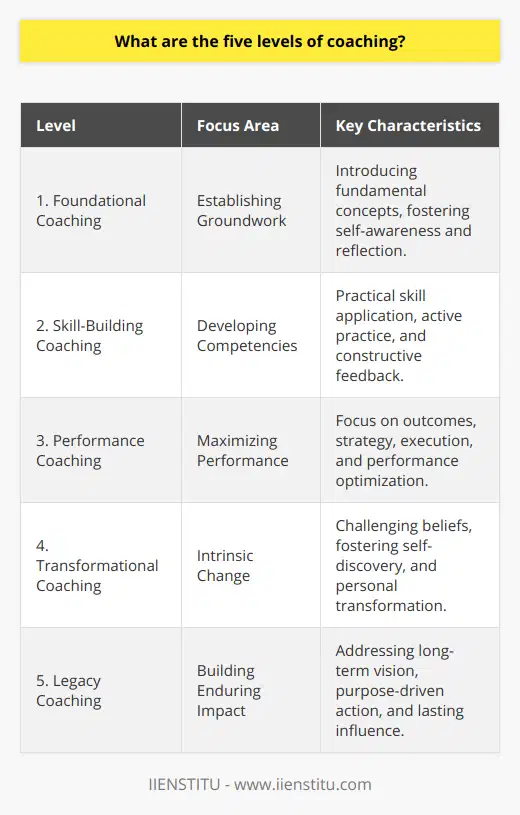
What is a system in coaching?
Defining Systems in Coaching
A system in coaching refers to the organized, methodical, and structured approach coaches employ to support the development, learning, and growth of a team or individual. This approach, grounded in proven theories and principles, enables coaches to facilitate specific outcomes and improvements for their athletes or clients. In essence, a systemized coaching methodology acts as the blueprint for the entire coaching process, ensuring all goals are met in a time-efficient and cost-effective manner.
Key Components of Coaching Systems
The foundation of a coaching system consists of several integral components that work in harmony to effectively produce desired outcomes. These components include:
Objectives and goals: Systems in coaching incorporate both short-term and long-term objectives that are continuously assessed and revised to adapt to the ever-evolving needs of the individual or team.
Strategies and techniques: A system incorporates numerous evidence-based strategies and practical techniques to enable coaches and clients to make informed decisions and implement personalized interventions.
Monitoring and evaluation: A robust coaching system employs regular assessment and monitoring processes to ensure that performance indicators align with predefined objectives and overall progress.
Continuous improvement: Adaptive coaching systems facilitate the identification and rectification of bottlenecks and areas of stagnation, leading to overall improvement in a coach's ability to assist individuals or teams in reaching their full potential.
Benefits of Systematic Coaching Approaches
The systematic nature of coaching provides many advantages to both coaches and their clients, such as:
Efficient use of resources: Implementing a systematic coaching approach allows coaches to allocate resources and time more effectively, thus maximizing the return on investment for both parties.
Tailored interventions: Systemized coaching empowers coaches to precisely identify areas that require attention and devise customized strategies for each individual or team, ultimately enhancing performance outcomes.
Accountability and communication: The structured nature of a coaching system ensures clear communication and fosters a greater sense of responsibility and collaboration between all parties involved.
In conclusion, a system in coaching encompasses a comprehensive and organized approach designed to support the optimal development of individuals or teams. Incorporating a clear direction, adaptable strategies, and ongoing monitoring and evaluation, this highly effective framework provides numerous benefits to coaches and clients alike, ensuring the successful achievement of desired outcomes.

How is a systemic approach to coaching applied in various contexts?
Contextualizing Systemic Coaching
Sporting Environment
In a sporting environment, a systemic approach to coaching entails analyzing the relationships between athletes, their performance, and the interpersonal dynamics within a team. The coach addresses aspects such as goal-setting, communication, and collaboration, thereby fostering overall team coherence and effectiveness. This approach aims to create a supportive, holistic atmosphere that encourages reflection, growth, and shared responsibility.
Organizational Settings
In organizational contexts, systemic coaching targets individuals and groups, emphasizing the interconnectedness of roles, responsibilities, and relationships within the workplace. It assists employees in gaining insights into their work style, improving decision-making, and managing stress. Additionally, it bolsters cross-functional collaboration, aligning personal and organizational goals. The ultimate objective is to cultivate a positive working culture that prioritizes collective growth and fosters adaptability to change.
Educational Institutions
For educational institutions, a systemic approach to coaching involves enhancing the learning environment, empowering educators, and supporting student development. This method prompts teachers to reflect on their teaching practices, adopt innovative strategies, and foster collaboration among students. Moreover, it involves engaging stakeholders – including parents, administrators, and community members – to create a cohesive support system that contributes to learners' academic and socio-emotional growth.
Clinical and Healthcare Contexts
In clinical and healthcare settings, systemic coaching focuses on patient care and team functioning. This approach enables healthcare professionals to assess their communication styles, crisis management, and leadership capabilities. It also helps practitioners navigate the complexities of their interdisciplinary roles, promoting efficient collaborations across various departments. Consequently, this holistic methodology enhances the overall quality of patient care and reinforces a collaborative, patient-centered culture.
Conclusion: The Unifying Principle
Across diverse contexts, the systemic approach to coaching strives to enhance individuals' self-awareness and develop their skills, fostering collaboration and understanding within the greater system. By concentrating on relational dynamics and interconnectedness, this methodology enables individuals and groups to actively participate in their collective growth and adapt to evolving circumstances. Ultimately, the systemic approach to coaching cultivates an environment where collaboration, communication, and personal growth are highly valued, leading to overall success and sustainability.
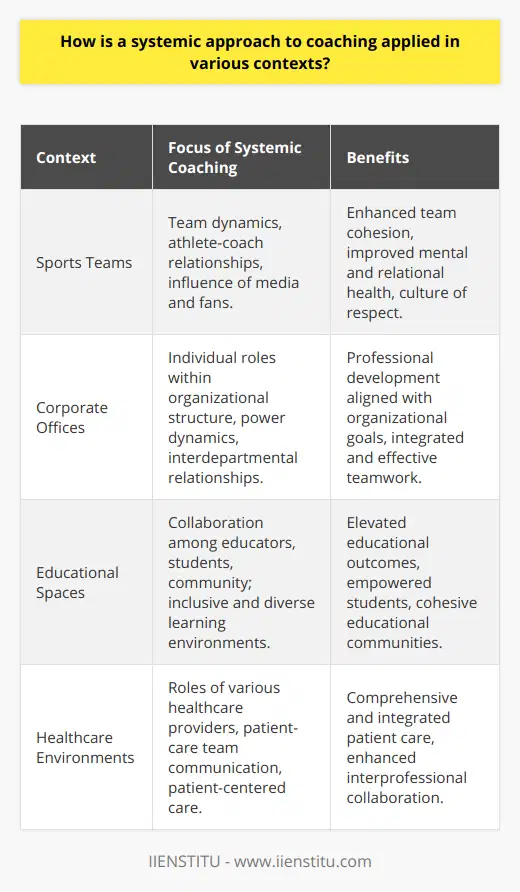
What is an example of systemic coaching?
Systemic Coaching: An Illustrative Example
Understanding the Concept
Systemic coaching represents a holistic approach that examines the broader contexts and interactions surrounding an individual or team. This coaching method fosters awareness of complex interdependencies and the influence they wield on personal and professional performance. By identifying and addressing systemic issues, coaches can facilitate meaningful change and growth within their clients.
Example: Team Dynamics in an Organization
A prime example of systemic coaching can be found in the context of an organization, where an executive coach is brought in to address issues related to team dynamics, communication, and collaboration. The coach begins by assessing the current situation and gathering data through one-on-one conversations, group interviews, or surveys.
Exploring Interconnections and Relationships
Upon identifying patterns, the coach works with the team to deepen their understanding of the relationships and interconnections within the group. They may, for instance, employ systems mapping techniques and engage the team in reflective dialogue. This process illuminates the underlying dynamics and mental models at play in the group's interactions.
Addressing Underlying Systemic Issues
Next, the coach focuses on addressing the systemic issues hindering the team's performance. Solutions could involve tackling communication barriers, challenging existing mindsets, or adjusting organizational structures. This step requires the team to take active ownership of identified challenges and collaboratively develop strategies for improvement.
Measuring Progress and Success
Lastly, the systemic coach supports the team in tracking their progress and evaluating the success of the intervention. By conducting regular follow-ups and gathering feedback, both the coach and the team can assess the impact of the systemic changes and adjust their strategies accordingly.
Conclusion
Systemic coaching exemplifies an effective, holistic approach to professional development that seeks to address the broader contexts and relationships surrounding an individual or a team. Through the examination of systemic issues and the implementation of targeted strategies, coaches can cultivate meaningful change within their clients, enhancing performance and fostering growth.
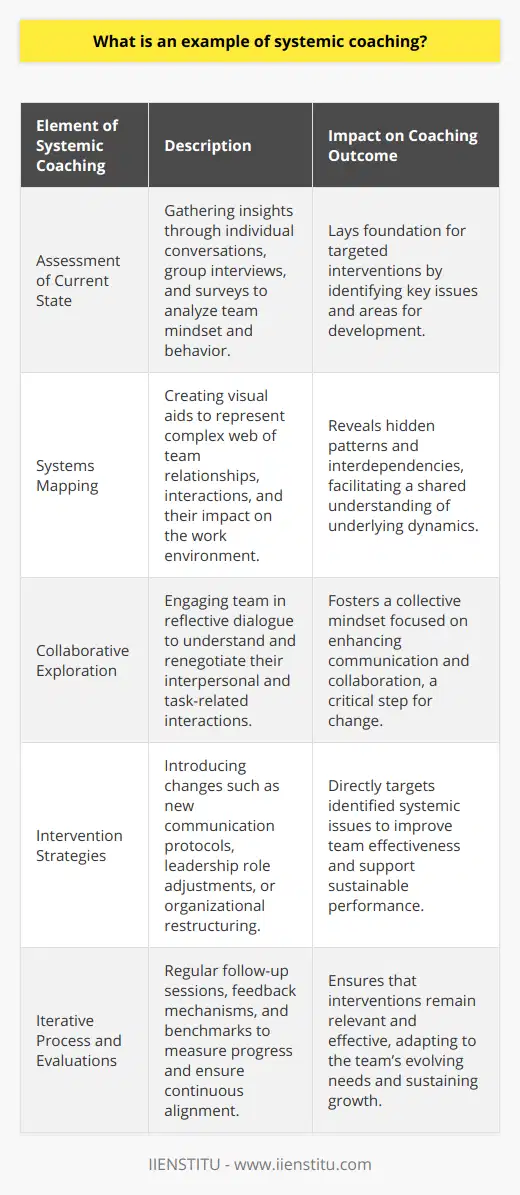
Why is systemic team coaching important?
Benefits of Systemic Team Coaching
Systemic team coaching is crucial for organizations and businesses because it fosters improved performance among their teams. By considering the entire system within which the team operates, this approach offers a more comprehensive solution for addressing teamwork-related challenges. It not only enhances team dynamics but also cultivates alignment with organizational goals and objectives.
Enhancing Team Dynamics
Team coaching supports team members in recognizing their strengths, weaknesses, and unique contributions. This self-awareness fosters improved communication, collaboration, and decision-making within the team. As a result, team members can adapt more effectively to changing environments and resolve conflicts with greater ease. In this way, systemic team coaching promotes shared understanding and a more cohesive team culture.
Cultivating Alignment with Organizational Goals
Systemic team coaching encourages teams to align their actions and decisions with the organization's overall objectives. By fostering a shared vision, this approach helps teams to contribute meaningfully to the organization's success. Additionally, systemic team coaching equips teams with the necessary skills and mindsets to navigate complex organizational structures and processes. These include skills such as strategic thinking, problem-solving, and resilience in the face of challenges.
Promoting Continuous Learning and Adaptation
Systemic team coaching supports continuous learning and adaptation within teams. By providing ongoing feedback loops and actionable insights, it enables teams to reflect on their performance, spot areas for improvement, and implement best practices. This iterative process facilitates growth and development, ensuring that teams can adapt to and effectively meet the demands of their work environment.
In conclusion, systemic team coaching is essential for teams that aim to excel in today's complex and ever-changing business landscape. This approach not only fosters better team dynamics but also ensures alignment with organizational goals, resulting in higher performance and success for both the team and the organization as a whole.
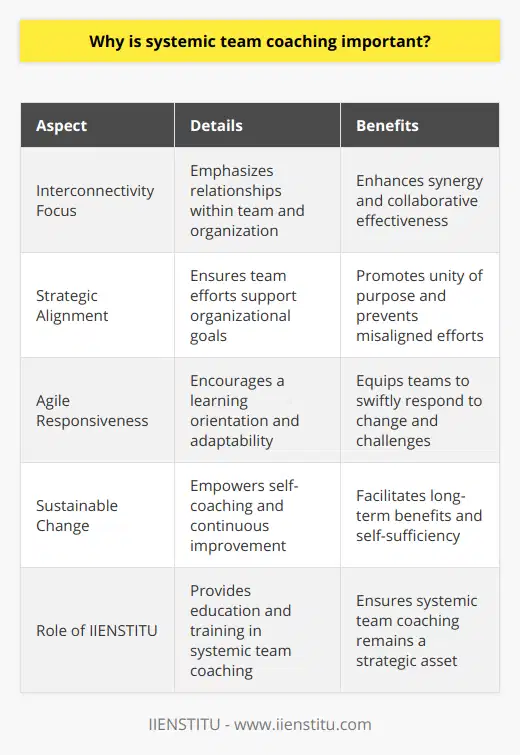
How do the principles of systems thinking apply to systemic coaching?
Understanding Systems Theory in Systemic Coaching
Systems thinking is a strategic approach that allows understanding interrelationships, patterns, and behaviors within different contexts. When applied to systemic coaching, it offers ways to investigate and solve problems by considering the wider system in which clients operate.
Client and Context Dynamics
A cornerstone of systems thinking is recognizing the dynamic interplay between elements. In systemic coaching, it is crucial to understand the client's underlying beliefs, values, and attitudes, as these shape their behavior and ultimately, their relationships with others. Furthermore, the coach needs to be aware of the context in which the client operates, including personal, professional, and cultural factors.
Holistic Problem-Solving Approach
Instead of merely focusing on specific issues or problem areas, systems thinking emphasizes a holistic approach in systemic coaching. By identifying patterns and trends, coaches can better comprehend the root causes of the client's concerns and assist them in exploring comprehensive solutions that account for the broader environment they operate within. This approach allows clients to develop long-term strategies and decision-making skills that contribute to a sustainable change in their personal and professional lives.
Inclusivity and Collaboration
Systemic coaching fosters inclusivity and collaboration, as it acknowledges that the client is a part of numerous systems that shape their experiences and decisions. Active engagement with different stakeholders (family members, colleagues, or organizational representatives) may be necessary during the coaching process. This approach enables the coach and the client to tap into collective wisdom, gain valuable insights, and build support networks to implement desired changes.
Adaptability and Flexibility
The ever-evolving nature of systems demands that systemic coaching remains adaptable and flexible. By incorporating continuous learning and feedback loops, coaches stay abreast with shifting individual needs and contextual factors affecting the client. These insights facilitate proactive adjustments to coaching techniques, intervention strategies, or even reconsidering goals to maximize the efficacy of the coaching process.
In conclusion, applying the principles of systems thinking to systemic coaching allows for a comprehensive understanding of the client's challenges and their interconnectedness within various systems. The holistic problem-solving approach ensures that solutions are viable and sustainable, while the collaborative and adaptable nature of the coaching relationship nurtures long-term development and growth for the client.
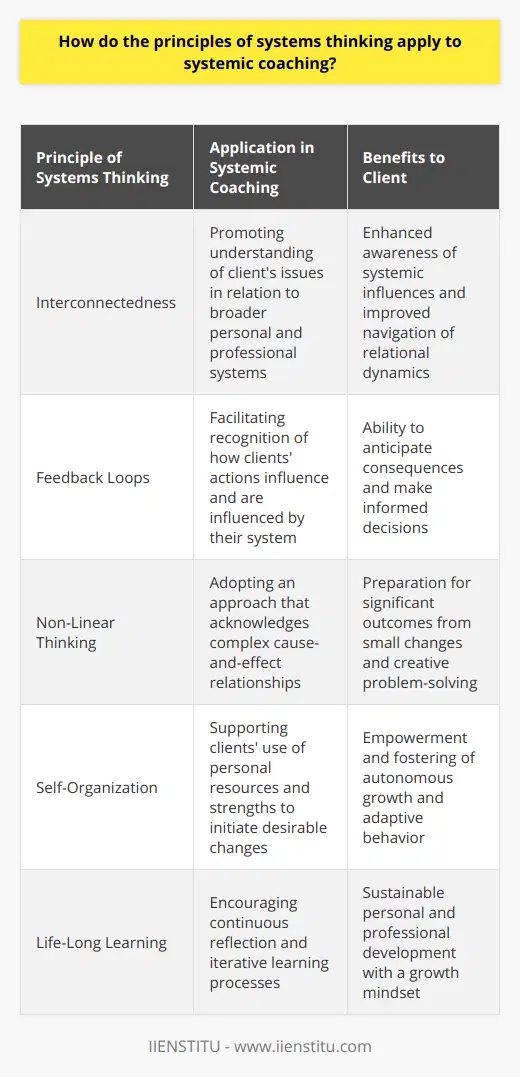
What is systemic team coaching?
Defining Systemic Team Coaching
Systemic team coaching is an approach that focuses on enhancing team performance and development by examining the complexities of team interactions and the organizational context within which they operate. This holistic method moves beyond individual coaching practices to create collective development interventions, considering the collective intelligence and interdependence of diverse teams as essential components for organizational success.
Elements of Systemic Team Coaching
In systemic team coaching, the coach works with various aspects of the team's ecosystem, including team members, team goals, relationships with stakeholders, and organizational culture. This multidimensional approach fosters the creation of sustainable solutions and lasting transformation for the team, as well as aligns the team's purpose and outcomes with the organization's broader strategy. Further, systemic team coaching integrates several discipline areas, including systems thinking, change management, and leadership development.
Benefits and Outcomes of Systemic Team Coaching
By adopting a systemic perspective, team coaching can address underlying issues that might hinder team performance, such as trust, communication, and conflict resolution. With the support of a skilled coach, teams can increase their self-awareness, learn how to leverage each other's strengths, and enhance decision-making processes that drive positive results. Additionally, systemic team coaching can help identify barriers and enablers in the broader organization that may impact the team's overall performance. Consequently, systemic team coaching can lead to improved collaboration, increased resilience, and higher levels of performance and innovation.
Implementing Systemic Team Coaching
To successfully implement systemic team coaching, organizations must be committed to invest in both time and resources. The process typically starts by establishing a clear coaching objective and identifying internal and external factors that might influence the team's effectiveness. Then, using various assessment tools and methodologies, the coach will gather data and feedback to create a comprehensive understanding of the team's current state. Based on this foundation, the coach will design interventions to foster the development of team capabilities, behaviors, and mindsets that contribute to achieving desired outcomes. Monitoring progress and evaluating results throughout the journey are crucial steps, ensuring that the team remains on track and adapts to changing circumstances as needed.
Systemic team coaching is an invaluable approach to maximizing a team's potential and delivering lasting changes that benefit both individual team members and the larger organization. By recognizing and addressing the diverse, interconnected factors that influence team performance, systemic team coaching paves the way for greater collaboration, resilience, and innovation within organizations.
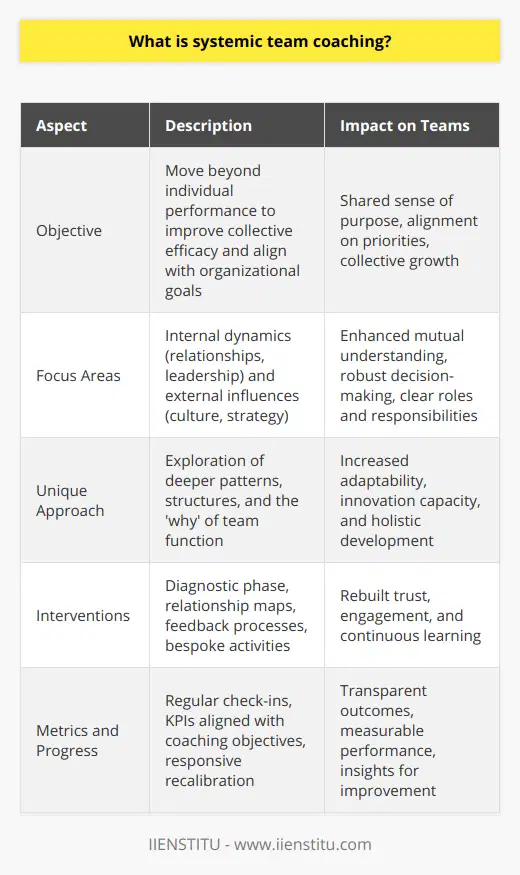
What are the 3 levels of coaching?
Three Levels of Coaching
Coaching is a process of helping individuals or teams to develop their skills, improve performance, and achieve goals. It is usually divided into three main levels, which can be discussed in terms of their purpose, the coaches involved, and the types of activities they are likely to engage in. These levels are:
Foundation Coaching
At the foundation level, coaching focuses on helping individuals develop basic skills and understanding of the sport or activity in question. This is often done with beginners, children, and youth, where the emphasis is on nurturing passion, engagement, and physical literacy.
In this level, coaches are typically volunteers, parents, or educators, who may not have extensive coaching experience or qualifications. However, they play a crucial role in cultivating a positive and inclusive environment, providing essential support, and encouraging enjoyment and long-term participation. Key activities at this stage include skill demonstrations, games, and drills that improve fundamental motor skills, communication, and teamwork.
Developmental Coaching
Developmental coaching is the next level and focuses on enhancing the performance of intermediate or advanced participants. This level introduces specialized techniques, strategies, and more sophisticated understanding of the sport or activity. Coaches at this stage are usually expected to have qualifications or training related to their sport, and a deeper knowledge of coaching principles.
In this level, individualized training programs, guidance on optimal nutrition, mental skills training, and sport-specific conditioning may be incorporated to help athletes or participants progress to higher levels of performance. Video analysis, strength and conditioning work, and competition preparation are common examples of activities at this stage.
High-Performance Coaching
At the highest level, coaches focus on refining and optimizing elite athletes or teams to reach their full potential and achieve success at the national, international, or professional level. High-performance coaching requires extensive expertise in coaching and sports science, as well as the ability to analyze and adapt to the latest research and practices in the field.
High-performance coaches work with advanced athletes and need to have exceptional technical and tactical knowledge, as well as an understanding of sports psychology, physiology, biomechanics, and performance analysis. At this level, coaches design and manage complex training programs, collaborate with interdisciplinary support teams (e.g., sports medicine, physiotherapy, etc.), and use cutting-edge technology and assessment tools to monitor and optimize athlete performance.
In conclusion, coaching occurs at three primary levels: foundation, developmental, and high-performance. Each level targets different participants' needs and requires varying degrees of coach expertise and resources. Regardless of the level, coaches play an essential role in nurturing talent, promoting personal growth, and fostering a love for the sport or activity.
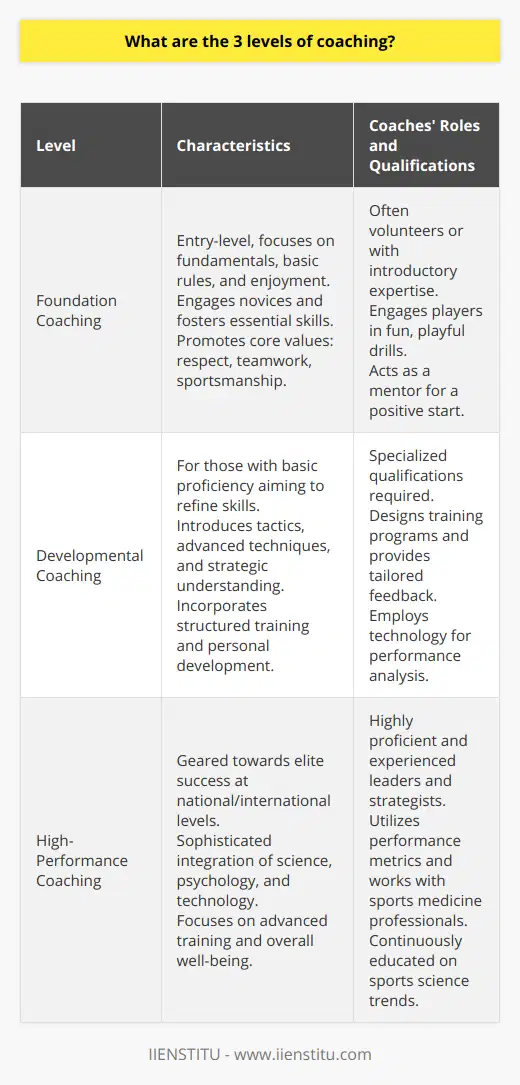
How does a systemic approach to coaching integrate individual and organizational development?
Systemic Approach Overview
A systemic approach to coaching goes beyond focusing on individual behavior and encompasses the broader organizational context. This method considers the interconnectedness of individuals, teams, and the organization as a whole, enabling coaches to address both individual and organizational development simultaneously. By analyzing systemic patterns, coaches can identify solutions that foster growth and development on multiple levels within the organization.
Integration of Individual and Organizational Development
One key aspect of integrating individual and organizational development is recognizing the dynamic relationship between personal growth and organizational success. In a systemic coaching approach, the growth of employees as individuals is seen as essential for the well-being of the organization. This mutual dependence is acknowledged and incorporated into the coaching process.
Organizational Culture and Values
A systemic approach also examines the organization's culture and values, which influence both individual behavior and group dynamics. By understanding the impact of these factors on employees, systemic coaches can facilitate development that is aligned with the organization's overall direction, leading to more sustainable change and progression.
Addressing Complex and Interdependent Issues
Systemic coaching highlights the complex and interdependent nature of issues within organizations. By focusing on the root causes of these issues, rather than targeting symptoms, coaches can develop strategies that support both individual and organizational growth. This helps achieving long-lasting results, as the interconnectedness of individual actions and organizational systems is taken into consideration.
Overall Benefits of Systemic Coaching Approach
In conclusion, a systemic approach to coaching allows for integrating individual and organizational development by examining the organization holistically. This method acknowledges the interdependence of personal growth and organizational success and addresses the complex issues that impact both entities. By taking into account organizational culture, values, and systemic patterns, coaches can develop strategies that foster sustainable change and progression on multiple levels within the organization.
